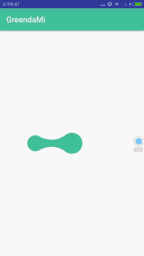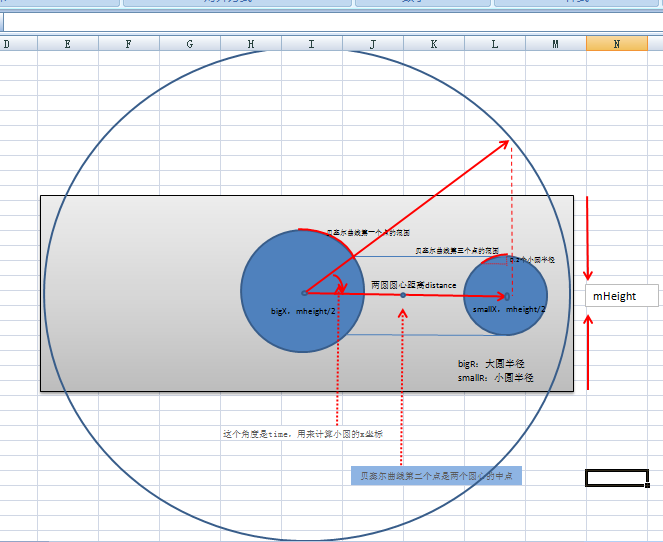您好,登錄后才能下訂單哦!
您好,登錄后才能下訂單哦!
小編給大家分享一下Android如何實現一個帶粘連效果的LoadingBar,相信大部分人都還不怎么了解,因此分享這篇文章給大家參考一下,希望大家閱讀完這篇文章后大有收獲,下面讓我們一起去了解一下吧!
前言
我們平時在開發的時候,發起網絡請求前,會需要顯示一個Loading,一般的做法都是在xml布局上添加好Loading,然后在Activity中,setVisibility來控制Loading的顯示和隱藏,這樣使用起來就很不方便,因為每一個xml都得引入一個Loading布局。
而LoadingBar就更好的解決了這個問題
最近設計師在外國的一個網站上挑了一個Loading的效果圖,嘗試實現之后,雖然和原圖有點不太一樣,但是效果還是不錯的。難點就是粘連效果的實現,貝塞爾曲線的點點們簡直要把我折磨死了。
先上效果圖:

實例代碼
然后是源碼,就是一個簡單VIew,可以直接放在xml中使用。
package top.greendami.greendami;
import android.content.Context;
import android.graphics.Canvas;
import android.graphics.Paint;
import android.graphics.Path;
import android.support.annotation.Nullable;
import android.util.AttributeSet;
import android.view.View;
/**
* Created by GreendaMi on 2017/3/17.
*/
public class PPView extends View {
String TAG = "PPView";
//動畫開關
boolean isLoading = true;
Context mContext;
private int mWidth = 100;
private int mheight = 100;
public int mColor;
public Paint mPaint = new Paint();
float time = 0;
//小球與中間打球的最遠距離
float distance = 100;
public PPView(Context context) {
super(context);
mContext = context;
}
public PPView(Context context, @Nullable AttributeSet attrs) {
super(context, attrs);
mContext = context;
mColor = context.getResources().getColor(R.color.colorPrimary);
init();
}
private void init() {
mPaint.setAntiAlias(true);
mPaint.setColor(mColor);
}
@Override
protected void onMeasure(int widthMeasureSpec, int heightMeasureSpec) {
super.onMeasure(widthMeasureSpec, heightMeasureSpec);
int widthSpecSize = MeasureSpec.getSize(widthMeasureSpec);
int heightSpecSize = MeasureSpec.getSize(heightMeasureSpec);
//寬度至少是高度的4倍
if (widthSpecSize < 4 * heightSpecSize) {
widthSpecSize = 4 * heightSpecSize;
}
mWidth = widthSpecSize;
mheight = heightSpecSize;
distance = 1.2f * mheight;
setMeasuredDimension(widthSpecSize, heightSpecSize);
}
@Override
protected void onDraw(Canvas canvas) {
super.onDraw(canvas);
if (isLoading) {
//大圓半徑
float bigR = mheight * 0.32f + mheight * 0.03f * Math.abs((float) Math.sin(Math.toRadians(time)));
float smallR = mheight * 0.22f + mheight * 0.03f * Math.abs((float) Math.cos(Math.toRadians(time)));
float bigx = (getWidth()) / 2;
//畫中間大圓
canvas.drawCircle(bigx, mheight / 2, bigR, mPaint);
float smalx = getSmallCenterX();
//畫小圓
canvas.drawCircle(smalx, mheight / 2, smallR, mPaint);
//畫鏈接
//小球在右側
if (smalx > bigx) {
Path path = new Path();
//上面的貝塞爾曲線的第一個點,在大圓身上
float x1 = bigx + bigR * (float) Math.cos(Math.toRadians(time));
float y1 = mheight / 2 - bigR * (float) Math.sin(Math.toRadians(time));
if (y1 > mheight / 2 - smallR) {
y1 = mheight / 2 - smallR;
x1 = bigx + (float) (Math.sqrt(bigR * bigR - smallR * smallR));
}
//上面的貝塞爾曲線的第三個點,在小圓身上
float x2 = smalx - smallR * (float) Math.cos(Math.toRadians(time));
float y2 = mheight / 2 - smallR * (float) Math.sin(Math.toRadians(time));
if (y2 > mheight / 2 - smallR * 0.8) {
y2 = mheight / 2 - smallR * 0.8f;
x2 = smalx - smallR * (float) (Math.sqrt(1-0.64f));
}
//下面的貝塞爾曲線的第三個點,在小圓身上
float x3 = smalx - smallR * (float) Math.cos(Math.toRadians(time));
float y3 = mheight / 2 + smallR * (float) Math.sin(Math.toRadians(time));
if (y3 < mheight / 2 + smallR * 0.8) {
y3 = mheight / 2 + smallR * 0.8f;
x3 = smalx - smallR * (float) (Math.sqrt(1-0.64f));
}
//下面的貝塞爾曲線的第一個點,在大圓身上
float x4 = bigx + bigR * (float) Math.cos(Math.toRadians(time));
float y4 = mheight / 2 + bigR * (float) Math.sin(Math.toRadians(time));
if (y4 < mheight / 2 + smallR) {
y4 = mheight / 2 + smallR;
x4 = bigx + (float) (Math.sqrt(bigR * bigR - smallR * smallR));
}
path.moveTo(x1, y1);
path.quadTo((bigx + smalx) / 2, mheight / 2, x2, y2);
// 繪制貝賽爾曲線(Path)
path.lineTo(x3, y3);
path.quadTo((bigx + smalx) / 2, mheight / 2, x4, y4);
canvas.drawPath(path, mPaint);
}
//小球在左側
if (smalx < bigx) {
Path path = new Path();
float x1 = bigx + bigR * (float) Math.cos(Math.toRadians(time));
float y1 = mheight / 2 - bigR * (float) Math.sin(Math.toRadians(time));
if (y1 > mheight / 2 - smallR) {
y1 = mheight / 2 - smallR;
x1 = bigx - (float) (Math.sqrt(bigR * bigR - smallR * smallR));
}
float x2 = smalx - smallR * (float) Math.cos(Math.toRadians(time));
float y2 = mheight / 2 - smallR * (float) Math.sin(Math.toRadians(time));
if (y2 > mheight / 2 - smallR * 0.8) {
y2 = mheight / 2 - smallR * 0.8f;
x2 = smalx + smallR * (float) (Math.sqrt(1-0.64f));
}
float x3 = smalx - smallR * (float) Math.cos(Math.toRadians(time));
float y3 = mheight / 2 + smallR * (float) Math.sin(Math.toRadians(time));
if (y3 < mheight / 2 + smallR * 0.8) {
y3 = mheight / 2 + smallR * 0.8f;
x3 = smalx + smallR * (float) (Math.sqrt(1-0.64f));
}
float x4 = bigx + bigR * (float) Math.cos(Math.toRadians(time));
float y4 = mheight / 2 + bigR * (float) Math.sin(Math.toRadians(time));
if (y4 < mheight / 2 + smallR) {
y4 = mheight / 2 + smallR;
x4 = bigx - (float) (Math.sqrt(bigR * bigR - smallR * smallR));
}
path.moveTo(x1, y1);
path.quadTo((bigx + smalx) / 2, mheight / 2, x2, y2);
// 繪制貝賽爾曲線(Path)
path.lineTo(x3, y3);
path.quadTo((bigx + smalx) / 2, mheight / 2, x4, y4);
canvas.drawPath(path, mPaint);
}
postInvalidate();
}
}
//計算小球的X坐標
private float getSmallCenterX() {
//此處控制速度
time = time + 2.5f;
return mWidth / 2 + distance * (float) Math.cos(Math.toRadians(time));
}
}“精心”畫了一張圖,對代碼做了說明。

在代碼中使用
<?xml version="1.0" encoding="utf-8"?> <RelativeLayout xmlns:android="http://schemas.android.com/apk/res/android" xmlns:tools="http://schemas.android.com/tools" android:layout_width="match_parent" android:layout_height="match_parent" android:background="@color/white" tools:context="top.greendami.greendami.MainActivity"> <top.greendami.greendami.PPView android:layout_centerInParent="true" android:layout_width="400dp" android:layout_height="80dp" /> </RelativeLayout>
以上是“Android如何實現一個帶粘連效果的LoadingBar”這篇文章的所有內容,感謝各位的閱讀!相信大家都有了一定的了解,希望分享的內容對大家有所幫助,如果還想學習更多知識,歡迎關注億速云行業資訊頻道!
免責聲明:本站發布的內容(圖片、視頻和文字)以原創、轉載和分享為主,文章觀點不代表本網站立場,如果涉及侵權請聯系站長郵箱:is@yisu.com進行舉報,并提供相關證據,一經查實,將立刻刪除涉嫌侵權內容。